Search
forProducts matching "restorative shampoo"
Tracking 3 products like 92 Hair Covet Hair Restoration Shampoo, 42 Revive Shampoo and 43 Restore Conditioner from by companies like MinoxidilMax and Roman. View all 3 products »
Sort by
Research
810-840 / 1000+ results
research Long-Term Follow-Up and Unusual Findings After Microvascular Transfer of Hair-Bearing Skin for Pubic Hair Restoration
Hair from the head was successfully used to restore pubic hair, with additional procedures suggested for more natural results.
research Complications in Hair Restoration Surgery
The document titled "Complications in Hair Restoration Surgery" from September 2000 discussed various complications associated with hair restoration procedures. The article highlighted that while hair restoration surgery could be effective, it was not without risks. Common complications included infection, scarring, and unnatural-looking hair growth. The study emphasized the importance of proper surgical technique and post-operative care to minimize these risks. It also suggested that patient selection and realistic expectations were crucial for successful outcomes. The article served as a guide for practitioners to improve patient safety and satisfaction in hair restoration surgeries.
research Surgical Hair Restoration in Women
Hair transplant surgery can effectively treat hair loss in women.

research Surgical Approaches to Hair Restoration
Experts suggest various surgical methods for hair restoration, including scalp reduction, transplantation using minigrafts, and establishing a permanent frontal hairline with follicular units. The drug finasteride may also be used alongside these procedures.
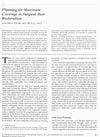
research Planning for Maximum Coverage in Surgical Hair Restoration
Walter P. Unger suggests using advanced hair transplant techniques for broader coverage, as they provide natural results and use donor tissue efficiently, while also recommending personalized planning due to the unpredictable progression of baldness.
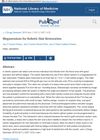
research Megasessions for Robotic Hair Restoration
Robotic hair restoration is efficient, minimally invasive, reduces scarring, and leads to quick healing with high patient satisfaction.

research Different Options in Revision Surgical Hair Restoration
Different hair restoration techniques like follicular unit extraction, scalp reduction, and body hair transplantation can improve results for patients unhappy with their initial surgery, but they also have potential risks.
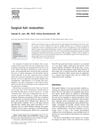
research Principles and Techniques of Surgical Hair Restoration
Surgical hair restoration involves moving hair from a non-balding area to a balding area, with the transplanted hair not subject to male pattern baldness. Medications can slow hair loss and regrow some hair, but successful treatment needs careful planning, skill, and ethical responsibility due to progressive hair loss and limited donor hair.
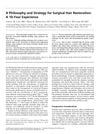
research A Philosophy and Strategy for Surgical Hair Restoration: A 10-Year Experience
The authors' 10-year experience shows that a personalized approach to hair restoration surgery, using various techniques, leads to natural results and high patient satisfaction.
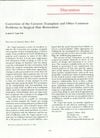
research Correction of the Cornrow Transplant and Other Common Problems in Surgical Hair Restoration
Dr. Vogel improved hair restoration by reducing and recycling hair plugs, achieving a more natural look and a 50-80% survival rate for replanted follicles. He emphasized understanding natural hair loss patterns, educating patients about alopecia, and refusing to operate on those who don't understand these aesthetics.
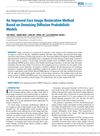
research An Improved Face Image Restoration Method Based on Denoising Diffusion Probabilistic Models
The new method improves facial image restoration quality and face recognition accuracy.

research Techniques for Hair Restoration
The document teaches methods to regrow hair.

research Training Module in Hair Restoration Surgery: A Simple Method for Beginning Physicians and Assistants
The document provides a simple method for beginners to learn hair restoration surgery.

research Training Module in Hair Restoration Surgery
Learn how to do hair restoration surgery.
research Controversies: What Would Hair Restoration Surgery Be Like If We Didn't Have Finasteride?

research Implanters in Hair Restoration
The document discusses how to use implanters in hair restoration.
research European Society of Hair Restoration Surgery: 10th Annual Congress and Live Surgery Workshop, Paris, France, May 24–27, 2007
research Dilemmas in Hair Restoration
The document "Dilemmas in Hair Restoration" from November 2006 discussed various challenges faced in the field of hair restoration. It highlighted the complexities involved in achieving natural-looking results, the limitations of existing techniques, and the ethical considerations in patient selection and treatment. The article emphasized the need for ongoing research and innovation to address these issues and improve outcomes for patients suffering from hair loss.
research European Society of Hair Restoration Surgery: 9th Annual Congress and Live Surgery Workshop, Zurich, Switzerland, May 25–28, 2006
research Evidence Based Hair Restoration: Designing Clinical Trials
The document discussed the application of Evidence-Based Medicine (EBM) in hair transplantation (HT). It highlighted the importance of designing robust clinical trials to improve the quality of evidence in HT. Specific challenges in conducting these studies were identified, such as variability in patient characteristics and the subjective nature of hair growth assessment. The authors proposed solutions like standardized protocols and objective measurement tools. The role of the International Society of Hair Restoration Surgery (ISHRS) in promoting high-quality research was emphasized. The conclusion stressed the need for well-designed clinical trials to advance the field of hair restoration.
research The Business of Hair Restoration: Can New Doctors Penetrate It?
The document discussed the challenges and opportunities for new doctors entering the hair restoration industry. It highlighted the competitive nature of the field and the importance of establishing a strong reputation and patient base. The article also emphasized the need for new practitioners to stay updated with the latest techniques and technologies to succeed. Additionally, it mentioned the role of professional organizations and forums in providing support and resources for newcomers. Overall, the article provided insights into the business aspects of hair restoration and offered guidance for new doctors aiming to penetrate the market.
research Growing the Hair Restoration Market
The document discussed the growth of the hair restoration market, emphasizing the importance of scientific insight and ethical standards in consultations. It highlighted the role of the International Society of Hair Restoration Surgery (ISHRS) in promoting these standards and supporting market growth. The article also suggested that individual physicians should adhere to these principles to ensure the continued expansion and credibility of the hair restoration field.

research Ergonomics Applied to Hair Restoration
Ergonomics can make hair restoration procedures more comfortable and efficient.
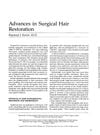
research Advances in Surgical Hair Restoration
Surgical hair restoration has improved since 1959, with new techniques like minigrafts, micrografts, and scalp reductions creating more natural hairlines and reducing bald skin, despite some risks and potential for scarring.
research Surgical Hair Restoration

research Innovative Therapies for Hair Restoration and Rejuvenation: An Overview
New non-surgical treatments for hair loss show promising results with fewer side effects.
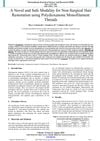
research A Novel and Safe Modality for Non-Surgical Hair Restoration Using Polydioxanone Monofilament Threads
PDO threads are effective and safe for non-surgical hair restoration.

research Advancements in Non-Shaven Techniques for Long Hair Restoration
The FUL hair restoration technique is better for aesthetics and causes less scarring.

research Robotic Hair Restoration
Robotic hair restoration is a safe, efficient alternative to manual hair transplant, best for men with dark, thick hair and skin, requiring sufficient donor hair and postoperative care.